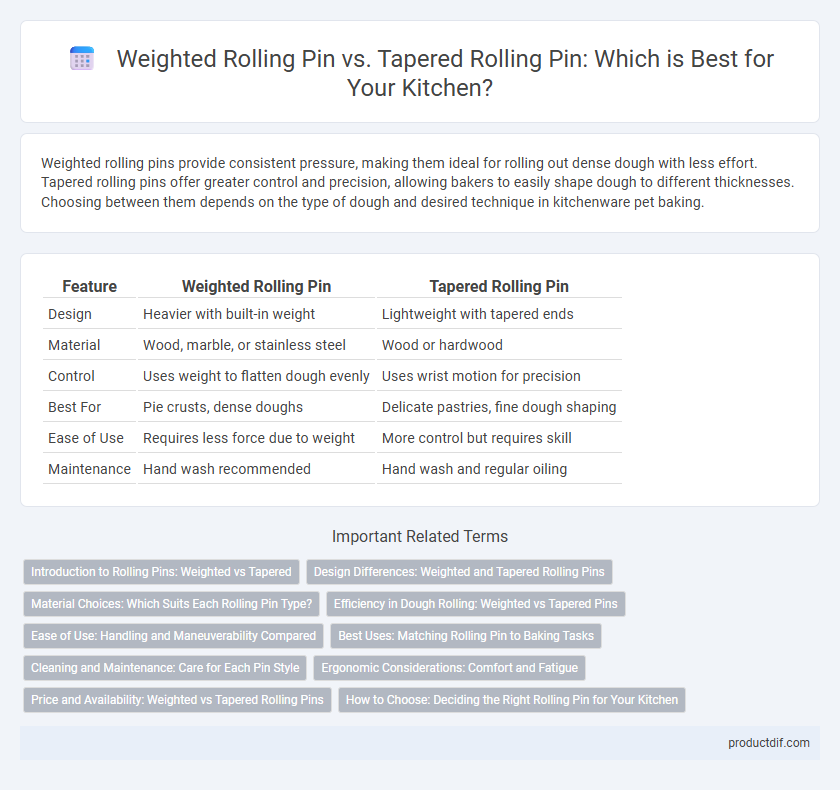Weighted rolling pins provide consistent pressure, making them ideal for rolling out dense dough with less effort. Tapered rolling pins offer greater control and precision, allowing bakers to easily shape dough to different thicknesses. Choosing between them depends on the type of dough and desired technique in kitchenware pet baking.
Table of Comparison
| Feature | Weighted Rolling Pin | Tapered Rolling Pin |
|---|---|---|
| Design | Heavier with built-in weight | Lightweight with tapered ends |
| Material | Wood, marble, or stainless steel | Wood or hardwood |
| Control | Uses weight to flatten dough evenly | Uses wrist motion for precision |
| Best For | Pie crusts, dense doughs | Delicate pastries, fine dough shaping |
| Ease of Use | Requires less force due to weight | More control but requires skill |
| Maintenance | Hand wash recommended | Hand wash and regular oiling |
Introduction to Rolling Pins: Weighted vs Tapered
Weighted rolling pins provide consistent pressure with their added mass, making dough rolling effortless and uniform, ideal for tasks requiring even thickness. Tapered rolling pins feature a slender design with tapered ends, offering precise control for shaping and adjusting dough thickness in artisanal baking. Choosing between weighted and tapered rolling pins depends on the desired dough texture and level of control during rolling.
Design Differences: Weighted and Tapered Rolling Pins
Weighted rolling pins feature a uniform cylindrical design with added internal weight, providing consistent pressure to effortlessly roll out dough. Tapered rolling pins have a narrower, conical shape at the ends, allowing for precise control over thickness and easy maneuverability. The weighted pin excels in even force distribution, while the tapered pin offers enhanced dexterity for shaping and delicate dough work.
Material Choices: Which Suits Each Rolling Pin Type?
Weighted rolling pins are commonly crafted from dense materials such as marble, stainless steel, or hardwood, providing consistent pressure ideal for rolling out dough evenly. Tapered rolling pins are typically made from lighter woods like maple or beech, offering greater control and flexibility for shaping delicate pastries and intricate dough designs. Selecting the right material depends on whether uniform weight or maneuverability is prioritized in baking tasks.
Efficiency in Dough Rolling: Weighted vs Tapered Pins
Weighted rolling pins provide consistent pressure across the dough, reducing the effort and time needed to achieve an even thickness, making them ideal for dense or sticky doughs. Tapered rolling pins offer greater control and precision, allowing bakers to adjust pressure and angle for delicate tasks like shaping pie crusts or pastry edges. Efficiency in dough rolling depends on the type of dough and baking task, with weighted pins excelling in uniform rolling and tapered pins in detailed, controlled work.
Ease of Use: Handling and Maneuverability Compared
Weighted rolling pins offer superior ease of use by reducing the need for additional pressure, allowing dough to be rolled out smoothly with minimal effort. Tapered rolling pins provide enhanced maneuverability and precise control, making them ideal for delicate tasks like shaping pastry edges. Both types cater to different handling preferences, with weighted pins favoring effortless rolling and tapered pins excelling in detailed dough manipulation.
Best Uses: Matching Rolling Pin to Baking Tasks
Weighted rolling pins provide consistent pressure ideal for rolling out dough evenly, making them perfect for pie crusts and cookies that require uniform thickness. Tapered rolling pins offer greater control and flexibility for shaping irregular doughs like croissants and pastries, allowing bakers to apply precise pressure at different points. Choosing between weighted and tapered models depends on the baking task, with weighted pins excelling at even rolling and tapered pins enhancing maneuverability for delicate or shaped doughs.
Cleaning and Maintenance: Care for Each Pin Style
Weighted rolling pins, typically made from heavy wood or marble, require thorough drying after washing to prevent moisture damage and warping, with occasional oiling recommended for wooden varieties to maintain their finish. Tapered rolling pins, often crafted from hardwood, benefit from gentle hand washing and prompt drying to preserve the wood's integrity and ensure smooth rolling performance. Avoid soaking both pin styles in water or placing them in dishwashers to extend lifespan and maintain optimal functionality.
Ergonomic Considerations: Comfort and Fatigue
Weighted rolling pins reduce wrist strain by distributing pressure evenly, minimizing fatigue during prolonged dough rolling. Tapered rolling pins offer greater control and precision, allowing ergonomic wrist movements that adapt to different dough consistencies. Both designs prioritize comfort, but weighted pins excel in reducing effort, while tapered pins enhance maneuverability.
Price and Availability: Weighted vs Tapered Rolling Pins
Weighted rolling pins typically cost more due to their added material density and even pressure distribution, making them ideal for heavy-duty dough tasks. Tapered rolling pins are generally more affordable and widely available in kitchenware stores and online, favored for their versatility in delicate dough shaping. Both options offer distinct advantages depending on budget and baking needs, with weighted models often less common but sought after by professional bakers.
How to Choose: Deciding the Right Rolling Pin for Your Kitchen
Weighted rolling pins provide consistent pressure and are ideal for rolling out dough evenly without much effort, making them perfect for beginners or those working with sticky dough. Tapered rolling pins offer greater control and maneuverability, allowing precise adjustments in pressure and thickness, preferred by experienced bakers for delicate pastries. Consider your baking style and dough type when choosing: opt for weighted pins for simplicity and uniformity, or tapered pins for versatility and finesse.
Weighted Rolling Pin vs Tapered Rolling Pin Infographic

 productdif.com
productdif.com